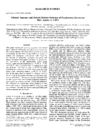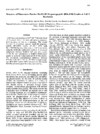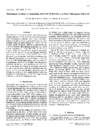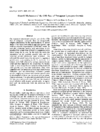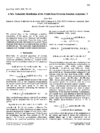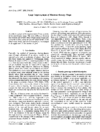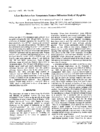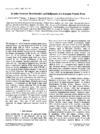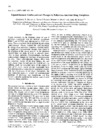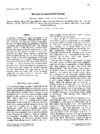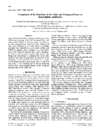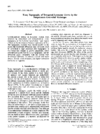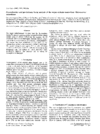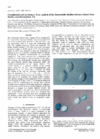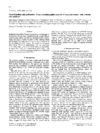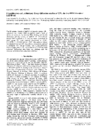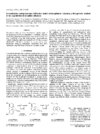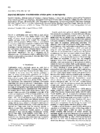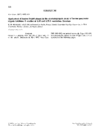issue contents
September 1997 issue

Cover illustration: View of interdomain interface of cell adhesion molecule VCAM-D1D2. The two hydrophobic patches (yellow from domain 1 and orange from domain 2) allow the domains to rock back and forth around the `pivot' residue Tyr89. The long C'E loop and FG loop seem to guide the movement. Courtesy of Jia-huai Wang.
research papers
The primary sequence and refined crystal structure of Pseudomonas fluorescens at 2.05 Å and a comparison with other know azurin structures.
PDB reference: 1joi
The crystal structure of monomeric porcine des B1-B2 despentapeptide (B26-B30) insulin (Des B1-2 DPI) has been determined at 1.65 Å resolution. Des B1-2 DPI is compared with other insulin derivatives.
PDB reference: 1sbd
Bullfrog M ferritin has been shown to crystallize in space group P41212 with a = b = 169.6, c = 481.2 Å; α = β = γ = 90°. The high crystallographic and molecular symmetry generated a diffraction pattern with unusual features which are analyzed and discussed.
Modelling of teragonal lysozyme (110) face growth rate indicates that growth occurs by addition of aggregates formed in solution. These aggregate growth units were determined from bond-chain analysis and correspond to 43 helices, which add to the surface by faceted crystal growth mechanisms.
The physical basis of the conditional probability distributions of the quartet and of the triplet are investigated by means of the Patterson and modulus sum functions, respectively.
A technique of `density growing' is proposed to improve poor density in regions of Fourier syntheses where the connectivity is lost.
Neutron diffraction data were collected at 80, 130, 180 and 240 K for myoglobin. The data show the onset of lattice disorder at 180 K.
The structure of a 64-residue scorpion toxin protein has been determined ab initio by the SnB program.
PDB reference: 1aho
Capsid-binding antiviral compounds block the infectivity of poliovirus by stabilizing the native conformation of the mature virion. The virus structure is noticeably changed only when the least effective antivirals are bound.
Open  access
access
 access
accessA Bayesian approach to MAD phasing emphasizing the correlation of errors among wavelengths is presented
Structures of horse-spleen apoferritin obtained from cubic (F432) and tetragonal (P4212) crystals, are compared.
X-ray diffraction topography has been employed to image growth-induced defects in tetragonal lysozyme crystals. Traditional diffraction studies were in good agreement with the topographic results. Crystals with fewer defects showed higher diffraction resolution.
short communications
Crystallization and preliminary X-ray diffraction studies of the Pseudomonas marginata esterase EstB
A novel esterase showing homology to β-lactamases has been crystallized and characterized by X-ray diffraction.
The 35 kDa endoglucanase of Thermoascus aurantiacus is identified as a member of subtype A6 of family 5 cellulases from its N-terminal sequence. Its crystallization and progress of structure solution by isomorphous replacement are reported.
Crystals of the fungal laccase from Coprinus cinereus have been grown in a form suitable for X-ray diffraction studies.
XT-6 is a thermostable alkaline-tolerant xylanase of group F which is of high biotechnological potential. A recombinant XT-6 has been crystallized recently and a full 2.3 Å resolution data set has been measured with synchrotron radiation under flash-freezing conditions.
The purification of recombinant shikimate kinase of Erwinia chrysanthemi and its crystallizationa and X-ray analysis. The use of mass spectrometry and dynamic light scattering to the success of crystallization is highlighted.
The N-terminal domain of human hnRNP A1 comprising both RNA-recognition motifs of the protein has been crystallized. A native data set to 2.0 Å, and two isomorphous derivative data sets from soaks with different mercurial compounds, one at 2.4 Å and the other at 2.5 Å, have been collected.
Crystals of morphinone reductase from Pseudomonas putida M10, a flavoprotein involved in the degradation of morphine-like alkaloids have been obtained in space group I212121. Preliminary molecular replacement calculations have been performed using Old Yellow Enzyme as a search model.
Microgravity crystallization of human antithrombin gave better ordered crystals with improved diffraction properties compared with earth-grown controls. This was assessed from single diffraction images using a novel algorithm that estimates the resolution of the Bragg scatter from single diffraction images, without requiring knowledge of the cell dimensions of the crystal.
addenda and errata
Free 

Erratum to Acta Cryst. (1997). D53, 262-268.


 journal menu
journal menu











